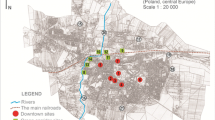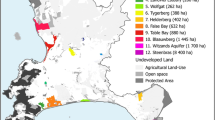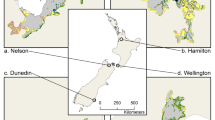Abstract
Urbanization is a key driver of global biodiversity loss. Although sub-Saharan African countries are experiencing unprecedented urbanization and urban expansion, very little is known about how this impacts tropical biodiversity. Here, we assessed the effects of urban expansion and urban green space on local small mammal species diversity in Accra, Ghana. We surveyed small mammals in the University of Ghana botanical garden, an urban green area (UGA) and adjoining built-up environment (BE) and compared the results with baseline data (BLD) collected when large areas of the current city still remained mostly undeveloped. The methodology involved live-trapping using Sherman collapsible live-traps. Our data showed higher small mammal abundance and diversity in the UGA than BE. Similarity of species composition was higher between UGA and BLD than between BE and BLD. The small mammal species captured in BE (the rodents Mastomys erythroleucus, Rattus rattus, and Arvicanthis rufinus, and the shrew Crocidura olivieri) are known to easily adapt to human-modified landscapes. Our results suggest that urbanization negatively influenced the abundance, diversity, and community composition of small mammals. Efforts should be directed towards the integration of urban green areas into urban land development planning in developing countries in order to conserve local wildlife and ecological services that enhance the quality of urban life.

Similar content being viewed by others
References
Allum, N., Sturgis, P., Tabourazi, D., & Brunton-Smith, I. (2008). Science knowledge and attitudes across cultures: a meta-analysis. Public Understanding of Science, 17(1), 35–54.
Aronson, M. F., La Sorte, F. A., Nilon, C. H., Katti, M., Goddard, M. A., Lepczyk, C. A., et al. (2014). A global analysis of the impacts of urbanization on bird and plant diversity reveals key anthropogenic drivers. Proceedings of Biological Science, 281(1780), 20133330. https://doi.org/10.1098/rspb.2013.3330.
Attuquayefio, D. K., Owusu, E. H., & Ofori, B. Y. (2017). Impact of mining and forest regeneration on small mammal biodiversity in the western region of Ghana. Environmental Monitoring and Assessment, 189(5), 237–245.
Beckett, K. P., Freer-Smith, P., & Taylor, G. (1998). Urban woodlands: their role in reducing the effects of particulate pollution. Environmental Pollution, 99(3), 347–360.
Bennett, A. B., & Gratton, C. (2012). Local and landscape scale variables impact parasitoid assemblages across an urbanization gradient. Landscape and Urban Planning, 104(1), 26–33.
Booth, A. H. (1959). On the mammalian fauna of the Accra Plain. Journal of the West African Science Association, 5, 26–36.
Bowler, D. E., Buyung-Ali, L., Knight, T. M., & Pullin, A. S. (2010). Urban greening to cool towns and cities: a systematic review of the empirical evidence. Landscape and Urban Planning, 97(3), 147–155.
Caula, S., Hvenegaard, G. T., & Marty, P. (2009). The influence of bird information, attitudes, and demographics on public preferences toward urban green spaces: The case of Montpellier, France. Urban Forestry & Urban Greening, 8(2), 117–128.
Cavia, R., Cueto, G. R., & Suárez, O. V. (2009). Changes in rodent communities according to the landscape structure in an urban ecosystem. Landscape and Urban Planning, 90(1), 11–19.
Clergeau, P., Jokimäki, J., & Savard, J. P. L. (2001). Are urban bird communities influenced by the bird diversity of adjacent landscapes? Journal of Applied Ecology, 38(5), 1122–1134.
Cox, D. T., & Gaston, K. J. (2015). Likeability of garden birds: Importance of species knowledge & richness in connecting people to nature. PLoS One, 10(11), e0141505.
David, J. P., Manakadan, R., & Ganesh, T. (2015). Frugivory and seed dispersal by birds and mammals in the coastal tropical dry evergreen forests of southern India: a review. Tropical Ecology, 56(1), 41–55.
Decher, J., & Bahian, L. K. (1999). Diversity and structure of terrestrial small mammal communities in different vegetation types on the Accra Plains of Ghana. Journal of Zoology, 247(3), 395–408.
Decher, J., Schlitter, D. A., & Hutterer, R. (1997). Noteworthy records of small mammals from Ghana with special emphasis on the Accra Plains. Annals of Carnegie Museum, 66, 209–227.
Dollman, G. (1912). Seven new African dormice. Annals and Magazine of Natural History, Ser, 8(9), 312–320.
Escobedo, F. J., Kroeger, T., & Wagner, J. E. (2011). Urban forests and pollution mitigation: analyzing ecosystem services and disservices. Environmental Pollution, 159(8), 2078–2087.
Faeth, S. H., Bang, C., & Saari, S. (2011). Urban biodiversity: patterns and mechanisms. Annals of the New York Academy of Sciences, 1223(1), 69–81.
Fernández, I. C., & Simonetti, J. A. (2013). Small mammal assemblages in fragmented shrublands of urban areas of Central Chile. Urban Ecosystems, 16(2), 377–387.
Garshong, R., Attuquayefio, D., & Gbogbo, F. (2013). Development on small mammal diversity and abundance on the Legon campus of the University of Ghana. West African Journal of Applied Ecology, 21(2), 1–9.
Gortat, T., Barkowska, M., Tkowska, A. G.-S., Pieniążek, A., Kozakiewicz, A., & Kozakiewicz, M. (2014). The effects of urbanization—small mammal communities in a gradient of human pressure in Warsaw city, Poland. Polish Journal of Ecology, 62(1), 163–172.
Grimes, L. G. (2006). Avifaunal and environmental changes on the campus of the University of Ghana, Legon, between the 1960s and 2004. Malimbus, 28(1), 57–68.
Grubb, P. (1971). Further records of mammals from Ghana, based on the collections of Angus Booth. Revue de Zoologie et de Botanique Africaines, 84, 192–202.
Güneralp, B., & Seto, K. (2013). Futures of global urban expansion: uncertainties and implications for biodiversity conservation. Environmental Research Letters, 8(1), 014025.
Hostetler, M., Allen, W., & Meurk, C. (2011). Conserving urban biodiversity? Creating green infrastructure is only the first step. Landscape and Urban Planning, 100(4), 369–371.
Hutterer, R., & Happold, D. C. D. (1983). The shrews of Nigeria. Bonner Zoologische Monographien, 18, 1–79.
Janhäll, S. (2015). Review on urban vegetation and particle air pollution–deposition and dispersion. Atmospheric Environment, 105, 130–137.
Jeník, J., & Hall, J. B. (1976). Plant communities of the Accra Plains, Ghana. Folia Geobotanica et Phytotaxonomica, Praha, 11, 163–212.
Kelcey, J. G. (2015). Vertebrates and invertebrates of European cities: selected non-avian Fauna: Springer, Boston, MA, USA.
Kingdon, J., Happold, D., Butynski, T., Hoffmann, M., Happold, M., & Kalina, J., Eds. (2013). Mammals of Africa (6 vols.), Bloomsbury Publishing, London
Kowarik, I. (2011). Novel urban ecosystems, biodiversity, and conservation. Environmental Pollution, 159(8), 1974–1983.
Lambin, E. F., Turner, B. L., Geist, H. J., Agbola, S. B., Angelsen, A., Bruce, J. W., et al. (2001). The causes of land-use and land-cover change: moving beyond the myths. Global Environmental Change, 11(4), 261–269.
Lättman, H., Bergman, K. O., Rapp, M., Tälle, M., Westerberg, L., & Milberg, P. (2014). Decline in lichen biodiversity on oak trunks due to urbanization. Nordic Journal of Botany, 32(4), 518–528.
Lee, A. C., & Maheswaran, R. (2011). The health benefits of urban green spaces: a review of the evidence. Journal of Public Health, 33(2), 212–222.
Łopucki, R., & Kiersztyn, A. (2015). Urban green space conservation and management based on biodiversity of terrestrial fauna–a decision support tool. Urban Forestry & Urban Greening, 14(3), 508–518.
Łopucki, R., & Kitowski, I. (2016). How small cities affect the biodiversity of ground-dwelling mammals and the relevance of this knowledge in planning urban land expansion in terms of urban wildlife. Urban Ecosystems, 20(4), 1–11.
Maimaitiyiming, M., Ghulam, A., Tiyip, T., Pla, F., Latorre-Carmona, P., Halik, Ü., Sawut, M., & Caetano, M. (2014). Effects of green space spatial pattern on land surface temperature: implications for sustainable urban planning and climate change adaptation. ISPRS Journal of Photogrammetry and Remote Sensing, 89, 59–66.
Marzluff, J. M. (2001). Worldwide urbanization and its effects on birds. Pp. 19–47. In Avian ecology and conservation in an urbanizing world (J. M. Marzluff, R. Bowman & R. Donnelly, eds.) Springer, Boston, MA, USA.
McKinney, M. L. (2002). Urbanization, biodiversity, and conservation: the impacts of urbanization on native species are poorly studied, but educating a highly urbanized human population about these impacts can greatly improve species conservation in all ecosystems. Bioscience, 52(10), 883–890.
McKinney, M. L. (2006). Urbanization as a major cause of biotic homogenization. Biological Conservation, 127(3), 247–260.
McKinney, M. L. (2008). Effects of urbanization on species richness: a review of plants and animals. Urban Ecosystems, 11(2), 161–176.
McPhearson, T., Pickett, S. T. A., Grimm, N. B., Niemelä, J., Alberti, M., Elmqvist, T., Weber, C., Haase, D., Breuste, J., & Qureshi, S. (2016). Advancing urban ecology toward a science of cities. BioScience, 66(3), 198–212. https://doi.org/10.1093/biosci/biw002.
Niemelä, J., & Kotze, D. J. (2009). Carabid beetle assemblages along urban to rural gradients: a review. Landscape and Urban Planning, 92(2), 65–71.
Oliveira, S., Andrade, H., & Vaz, T. (2011). The cooling effect of green spaces as a contribution to the mitigation of urban heat: a case study in Lisbon. Building and Environment, 46(11), 2186–2194.
Otoo, E. A., Whyatt, D. J., & Ite, U. E. (2006). Quantifying urban growth in Accra Metropolitan Area (AMA), Ghana and exploring causal mechanisms. Paper presented at the 5th FIG Regional Conference (PP. 8–11).
Pauchard, A., Aguayo, M., Peña, E., & Urrutia, R. (2006). Multiple effects of urbanization on the biodiversity of developing countries: the case of a fast-growing metropolitan area (Concepción, Chile). Biological Conservation, 127(3), 272–281.
Payne, S. L., Symes, C. T., & Witkowski, E. T. (2016). Of feathers and fur: differential pollinator roles of birds and small mammals in the grassland succulent Aloe peglerae. Austral Ecology, 41(8), 952–963.
Pearce, J., & Venier, L. (2005). Small mammals as bioindicators of sustainable boreal forest management. Forest Ecology and Management, 208(1), 153–175.
Peck, M. R., Maddock, S. T., Morales, J. N., Oñate, H., Mafla-endara, P., Peñafiel, V. A., et al. (2014). Cost-effectiveness of using small vertebrates as indicators of disturbance. Conservation Biology, 28(5), 1331–1341.
Rosevear, D. R. (1969). The rodents of West Africa: trustees of the British Museum (natural history).
Savard, J.-P. L., Clergeau, P., & Mennechez, G. (2000). Biodiversity concepts and urban ecosystems. Landscape and Urban Planning, 48(3), 131–142.
Scherner, F., Horta, P. A., de Oliveira, E. C., Simonassi, J. C., Hall-Spencer, J. M., Chow, F., et al. (2013). Coastal urbanization leads to remarkable seaweed species loss and community shifts along the SW Atlantic. Marine Pollution Bulletin, 76(1), 106–115.
Schneider, A., Friedl, M. A., & Potere, D. (2010). Mapping global urban areas using MODIS 500. m data: New methods and datasets based on ‘urban ecoregions’. Remote Sensing of Environment, 114(8), 1733–1746.
Setälä, H., Viippola, V., Rantalainen, A.-L., Pennanen, A., & Yli-Pelkonen, V. (2013). Does urban vegetation mitigate air pollution in northern conditions? Environmental Pollution, 183, 104–112.
Seto, K. C., Güneralp, B., & Hutyra, L. R. (2012). Global forecasts of urban expansion to 2030 and direct impacts on biodiversity and carbon pools. Proceedings of the National Academy of Sciences, 109(40), 16083–16088.
Seto, K. C., Parnell, S., & Elmqvist, T. (2013). A global outlook on urbanization. Pp. 1–12 in urbanization, biodiversity and ecosystem services: challenges and opportunities (T. Elmqvist et al. eds). Springer Netherlands. https://doi.org/10.1007/978-94-007-7088-1.
Shochat, E., Lerman, S., & Fernández-Juricic, E. (2010). Birds in urban ecosystems: population dynamics, community structure, biodiversity, and conservation. Urban Ecosystem Ecology. Pp. 75-86. In Urban Ecosystem Ecology (J. Aitkenhead-Peterson and A. Volder, eds.), Agronomy Mongraphs 55. American Society of Agronomy, Inc., Crop Science Society of America, Inc., Soil Science Society of America.
Shwartz, A., Turbé, A., Simon, L., & Julliard, R. (2014). Enhancing urban biodiversity and its influence on city-dwellers: An experiment. Biological Conservation, 171, 82–90.
Sikes, R. S., & Animal Care and Use Committee of the American Society of Mammalogists. (2016). Guidelines of the American Society of Mammalogists for the use of wild mammals in research and education. Journal of Mammalogy, 97(3), 663–688.
Sol, D., González-Lagos, C., Moreira, D., Maspons, J., & Lapiedra, O. (2014). Urbanisation tolerance and the loss of avian diversity. Ecology Letters, 17(8), 942–950.
Sushinsky, J. R., Rhodes, J. R., Possingham, H. P., Gill, T. K., & Fuller, R. A. (2013). How should we grow cities to minimize their biodiversity impacts? Global Change Biology, 19(2), 401–410.
Tyrväinen, L., Ojala, A., Korpela, K., Lanki, T., Tsunetsugu, Y., & Kagawa, T. (2014). The influence of urban green environments on stress relief measures: a field experiment. Journal of Environmental Psychology, 38, 1–9.
Ulmer, J. M., Wolf, K. L., Backman, D. R., Tretheway, R. L., Blain, C. J., O’Neil-Dunne, J. P., & Frank, L. D. (2016). Multiple health benefits of urban tree canopy: The mounting evidence for a green prescription. Health & Place, 42, 54–62.
United Nations, Department of Economic and Social Affairs, Population Division (2015). World urbanization prospects: The 2014 revision, (ST/ESA/SER.A/366). https://esa.un.org/unpd/wup/publications/files/wup2014-report.pdf
Vakhlamova, T., Rusterholz, H.-P., Kanibolotskaya, Y., & Baur, B. (2014). Changes in plant diversity along an urban–rural gradient in an expanding city in Kazakhstan, Western Siberia. Landscape and Urban Planning, 132, 111–120.
Wilson, D. E., & Reeder, D. M. (2005). Mammal species of the world: a taxonomic and geographic reference (3rd Ed.). 2 Volumes. Baltimore: Johns Hopkins University Press.
Wolch, J. R., Byrne, J., & Newell, J. P. (2014). Urban green space, public health, and environmental justice: the challenge of making cities ‘just green enough’. Landscape and Urban Planning, 125, 234–244.
Yang, J., McBride, J., Zhou, J., & Sun, Z. (2005). The urban forest in Beijing and its role in air pollution reduction. Urban Forestry & Urban Greening, 3(2), 65–78.
Acknowledgements
The Management of the Kotoka International Airport, Accra-Ghana gave permission for the small mammal survey to be undertaken at the airport area.
Author information
Authors and Affiliations
Rights and permissions
About this article
Cite this article
Ofori, B.Y., Garshong, R.A., Gbogbo, F. et al. Urban green area provides refuge for native small mammal biodiversity in a rapidly expanding city in Ghana. Environ Monit Assess 190, 480 (2018). https://doi.org/10.1007/s10661-018-6858-1
Received:
Accepted:
Published:
DOI: https://doi.org/10.1007/s10661-018-6858-1




